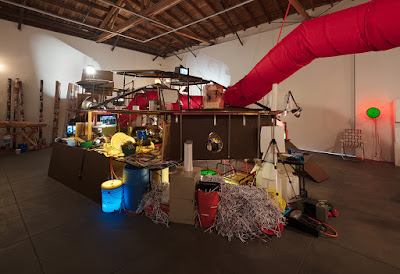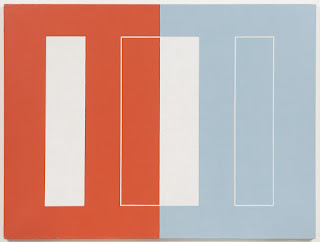Jason Rhoades: Installations
1994 – 2006
Hauser Wirth & Schimmel, Los Angeles Exhibition through May 21st
Article by Cathy Breslaw
 |
|
Jason Rhoades My Madinah. In pursuit of my ermitage... 2004 Mixed media Dimensions variable
Installation view, ‘Jason Rhoades. Installations, 1994 –
2006’ Hauser Wirth & Schimmel, 2017 © The Estate of Jason Rhoades
Courtesy the estate, Hauser & Wirth and David
Zwirner
Photo: Fredrik Nilsen
|
Jason Rhoades’s artist legacy
was sealed at forty-one years of age when he died unexpectedly – at a time in life when most artists are only coming
into their own. At Hauser, Wirth
& Schimmel, Rhoades six separate sprawling
room-sized installations (created between 1994 – 2006) breathe life into his memory. He created
these works ten years or more ago, yet they speak to timely current gender and
racial politics, and our consumer culture. His work is bold and
unselfconscious, pushing taboos aside to explore relationships of consumption to
porn and sex using female genitalia as the symbolic vehicle for his creations. Swedish Erotica and Fiero Parts (1994) is
his only work referencing the urban and cultural landscape of LA. Tons of ordinary items, all in a unifying
yellow color including cardboard, styrofoam, scrap wood, and more, are arranged
to create sitting areas of small and large tables and chairs, bookshelves,
including items of common consumption like rolls of toilet paper and reference
Duchampian notions of the readymade. In My Brother/Brancuzi
(1995) Rhoades juxtaposes his brother’s bedroom with famous sculptor
Brancusi’s studio, with photographs along the large perimeter of the
installation as well as mechanical objects, a toy monster truck, mini-bike and an
industrial style doughnut maker – all drawing connections to the mechanics of the
creation of Brancusi’s sculpture. In The
Creation Myth (1998) Rhoades sought to understand why, how and what humans
create by exploring Creationist/Evolutionist theories. Large tables are stacked
throughout the huge installation and large white buckets are used to identify
and distinguish the brain, and mind, body and spirit. He uses a moving electric
toy train engine with a toy stuffed snake on top as metaphor for “train of
thought”. Literally ‘smoke rings’ emerge from a machine, as metaphor for a personification
of the ‘spirit’ which is ephemeral. My
Medinah, In pursuit of my ermitage…(2004),
is an installation created with tables, wood parts, photographic covered
poles, TVs, buckets and more representing part mosque, part temple creating a
place of religious seclusion. Once again
female genitalia imagery float above the
scene, highlighting political incorrectness, taboos and hypocrisies. The Black Pussy…and the Pagan Idol Workshop
(2005) was inspired by the intersection of commerce and religion, and the ancient pre-Islamic
story of the Kaaba. The installation comprises five core elements:
Egyptian-made hookah pipes and paraphernalia , dream catchers, beaver-felt
cowboy hats, a collection of ancient gongshi stones, and ultraviolet neon words
depicting slang for vagina. This was this installation’s first time being
shown. Tijuanatanjierchandelier (2006) , the most recently created
installation prior to Rhoade’s death, raises questions about consumerism in
relation to tourism using border towns Tijuana Mexico and TangierMorocco as
examples. With these cities, though 6,000
miles apart, Rhoades blends trinkets with chandeliers, incorporating 176
Spanish and English neon “pussy words” transforming the act of consumption into
an adventure of global trade. Mixing the Moroccan and Mexican tourist trade
forces us to look at cultural stereotypes tourism encourages. Prior to 2006,
Rhoade’s work was widely exhibited in Europe however this exhibition is the
first comprehensive survey presented in his adopted city, Los Angeles. These
complex installations are beautifully installed and the gallery provides the
kind of massive spaces required to exhibit these mesmerizing mind-bending
installations packed full of imagery, and cultural meaning.
 |
|
Jason Rhoades Tijuanatanjierchandelier 2006 Mixed media Dimensions variable
Installation view, ‘Jason Rhoades. Installations, 1994 –
2006’
Hauser Wirth & Schimmel, 2017 © The Estate of Jason Rhoades
Courtesy the estate, Hauser & Wirth, David Zwirner
and lender
Photo: Fredrik Nilsen
|
 |
|
Jason Rhoades The Creation Myth1998 Mixed media Dimensions variable
Installation view, ‘Jason Rhoades. Installations, 1994 –
2006’ Hauser Wirth & Schimmel, 2017
© The Estate of Jason Rhoades
Courtesy Friedrich Christian Flick Collection im
Hamburger Bahnhof, Berlin
Photo: Fredrik Nilsen
|






